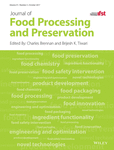Opuntia dillenii (Ker-gawl) haw fruit peel pectin: Physicochemical, rheological, and functional behavior
Funding information: CSIR-CFTRI, Mysore; Department of Biotechnology, Govt. of India, New Delhi
Abstract
High methoxyl low molecular weight pectin was extracted from Opuntia dillenii fruit peel under three acidic media. The effect of extraction medium on the yield and quality characteristics of pectin was investigated. The extracted samples consisted preponderantly galacturonic acid (68.2–74.0%) with minor quantities of neutral sugars viz., galactose (10.2–12.4%), arabinose (4.4–5.4%), and rhamnose (0.9–3.2%). DE (degree of esterification) of pectin samples estimated by FTIR ranged from 63% to 85%. The rheological properties of pectin showed decreased viscosity with increasing shear rate resulting in shear thinning flow features. Determination of intrinsic viscosity (1.4–3.5 dL/g) and molecular weight (21–76 kDa) showed significant differences among the extracted samples. All the samples were nonsticky, good flow ability, exhibited good functional properties like emulsion capacity and stability. The study advocates O. dillenii fruit peel as a source of high methoxy pectin for use in food and food allied industries.
Practical applications
The isolation of pectin from Opuntia dillenii pear peel with different extraction media was investigated to evaluate its quality with respect to yield and functional properties. CAP (Citric acid extracted pectin) was found to be HMP, higher yield with low ash content thereby enhancing the functional properties. Besides, it promotes the use of the underutilized, cactus crop as a source of pectin that can substitute other commercial HMP pectin used in food and pharmaceutical industries.




